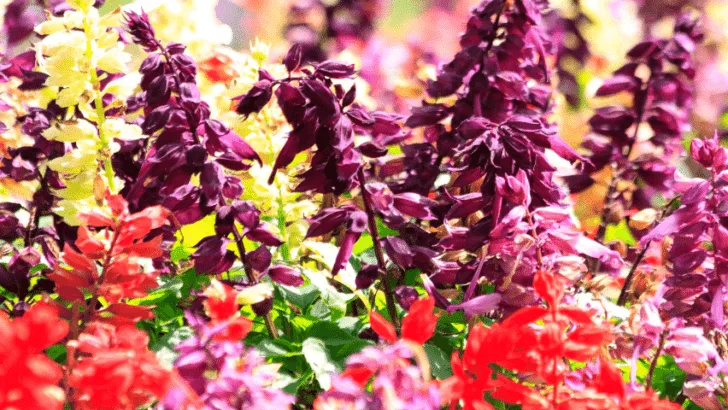Different types of sage plants – What is sage, and how many types of sage are there?
A sage plant belongs to the Lamiaceae family. The scientific name of sage is Salvia Officinalis, according to Winsconsin Horticulture.
Sage plants are hardy and can adapt to the changes in the environment and survive.
Due to this, they can be grown in other parts of the world.
Sage is an aromatic perennial herbaceous plant. With that, they are low-maintenance.
900 species of Salvia grow worldwide, and there are many different types of sage.
Each type has unique properties and smells.
Here are some of the popular types of sage and their properties.
20 Types of Sage
- Blackcurrant Sage (Salvia microphylla)
- White Sage (Salvia apiana)
- Thunder Cloud Sage (Leucophyllum candidum)
- Sonoma Sage (Salvia sonomensis)
- Mexican Bush Sage (Salvia leucantha)
- Pineapple Sage (Salvia elegans)
- Canary Island Sage (Salvia canariensis)
- Hummingbird Sage (Salvia spathacea)
- Jerusalem Sage (Phlomis fruticosa)
- Grape-Scented Sage (Salvia melissodora)
- Greek Sage (Salvia fruticosa)
- Clary Sage (Salvia sclarea)
- Cleveland Sage (Salvia clevelandii)
- Diviner’s sage (Salvia divinorum)
- Anise-Scented Sage (Salvia guaranitica)
- Autumn Sage (Salvia greggii)
- Common Garden Sage (Salvia officinalis)
- Fragrant Pitcher Sage (Lepechinia fragrans)
- Woodland Sage (Salvia nemorosa)
- Scarlet Sage (Salvia splendens)
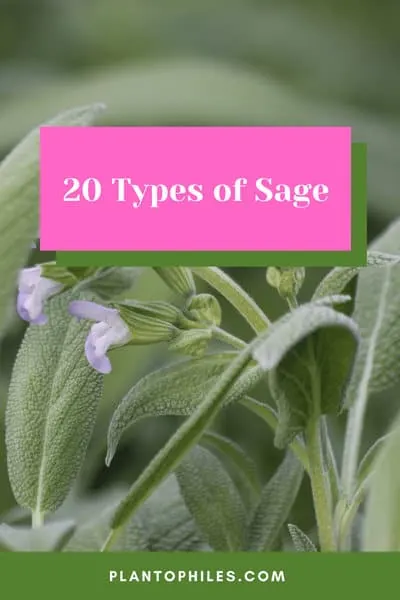
Table of Contents
20 Types of Sage
1. Blackcurrant Sage
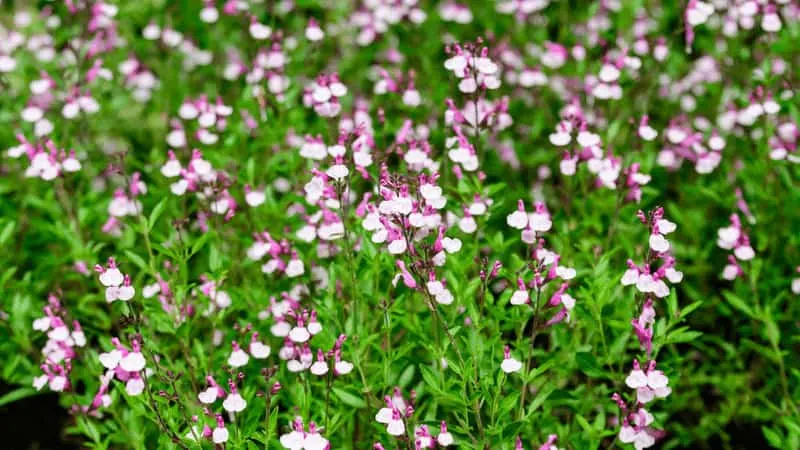
Blackcurrant sage is a perennial plant. The color of its leaves is grey-green, containing a purple shade beneath.
They can be used for medical and culinary applications.
The tubular flowers of this plant are produced in the summer season. They have pink and purple flowers.
Following are the binomial nomenclature and basic plant care requirements:
- Scientific name: Salvia microphylla
- Family: Lamiaceae
- Temperature: 0 to 5 degrees Fahrenheit (-17.8 to -15 degrees Celsius)
- Fertilizer: Fertilizer is not that important for these plants. However, for better yield of the plant, you can use NPK fertilizer with a ratio of 5:5:5
- pH: 5.0 to 8.5
- Soil: They require free draining of the soil
- Lighting: Partial shade or sunny
- Growth rate: Moderate to fast-growing
- Humidity: Moderate
2. White Sage
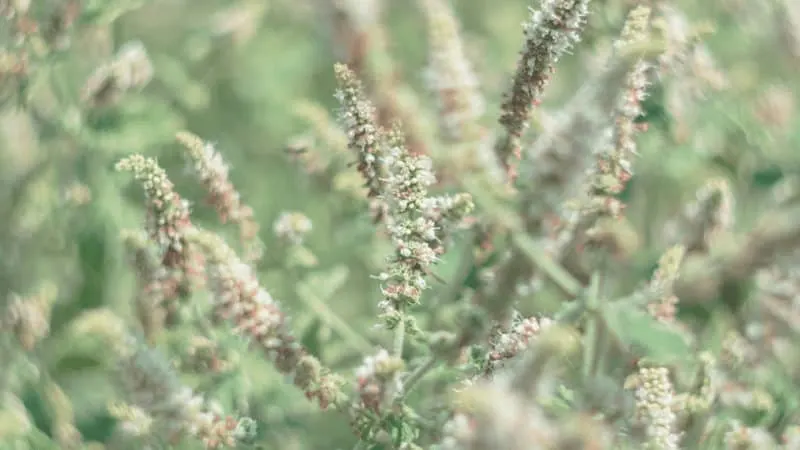
White sage is a perennial shrub. It grows up to the height of 3 to 4 feet.
When the flower thorns grow, the height may be up to 8 feet.
The young leaves are green in color, changing to white when they grow older.
Following are the binomial nomenclature and basic plant care requirements:
- Scientific name: Salvia apiana
- Family: Lamiaceae
- Temperature: 65 to 70 degrees Fahrenheit (18 to 21 degrees Celsius)
- Fertilizer: They do not need fertilizing
- pH: 6.0 to 7.0
- Soil: Sandy, well-draining soil
- Lighting: Minimally six hours of direct sunlight daily
- Growth rate: Slow growing, they reach the maximum height in two to three years
- Humidity: can tolerate less to moderate humidity
3. Thunder Cloud Sage
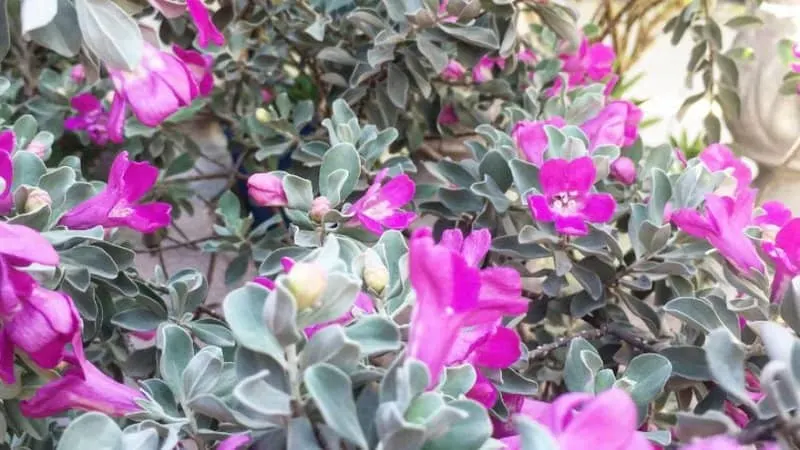
They bloom periodically after rain. Their foliage is white, small, and hairy.
They are irregular-shaped shrubs and can grow to a height and width of 5 feet.
Their stems are delicate when the plant is young, and they attain a woody texture when the plant grows.
Following are the binomial nomenclature and basic plant care requirements:
- Scientific name: Leucophyllum candidum
- Family: Lamiaceae
- Temperature: 15 degrees Fahrenheit (9 degrees Celsius)
- Fertilizer: They do not need fertilizing
- pH: 6.5 to 8.5
- Soil: Well-draining soil
- Lighting: Full Sun, Partial Shade
- Growth rate: Fast-growing
- Humidity: Moderate to high
3. Sonoma Sage
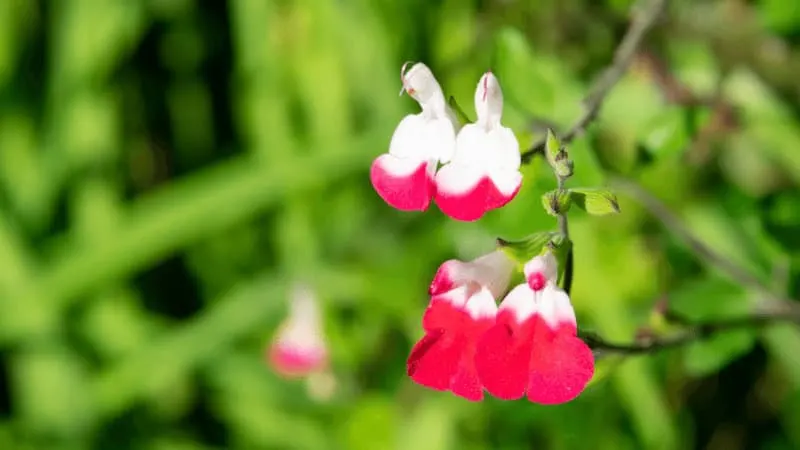
It is also called creeping sage. Its stems do not grow more than 40 centimeters high. The leaves are hairy.
The underside of the leaves is densely covered with hair, so it appears white.
This plant grows up to 1 foot and 15 feet wide in favorable conditions.
Following are the binomial nomenclature and basic plant care requirements:
- Scientific name: Salvia sonomensis
- Family: Lamiaceae
- Temperature:
- Fertilizer:
- pH: 5.0-7.5
- Soil: Well-drained soil
- Lighting: Full sun, partial shade
- Growth rate: Moderately growing
- Humidity: Very low
4. Mexican Bush Sage
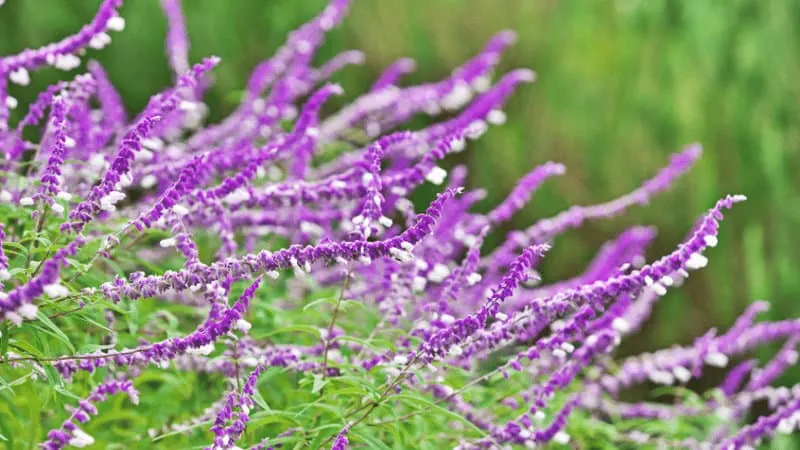
These colorful plants grow up to the height and width of four feet.
They have greyish-green wrinkled foliage. It can be grown around ponds, pools, and perennial gardens.
Following are the binomial nomenclature and basic plant care requirements:
- Scientific name: Salvia leucantha
- Family: Lamiaceae
- Temperature: 30 to 40 degrees Fahrenheit (-1 to 4 degrees Celsius)
- Fertilizer: They require fertilizers once a month. Use a balanced 10-10-10 NPK fertilizer.
- pH: 4.5 to 8.0
- Soil: Well-drained soil
- Light: Full sun
- Growth rate: Moderately growing
- Humidity: Moderate to high
5. Pineapple Sage
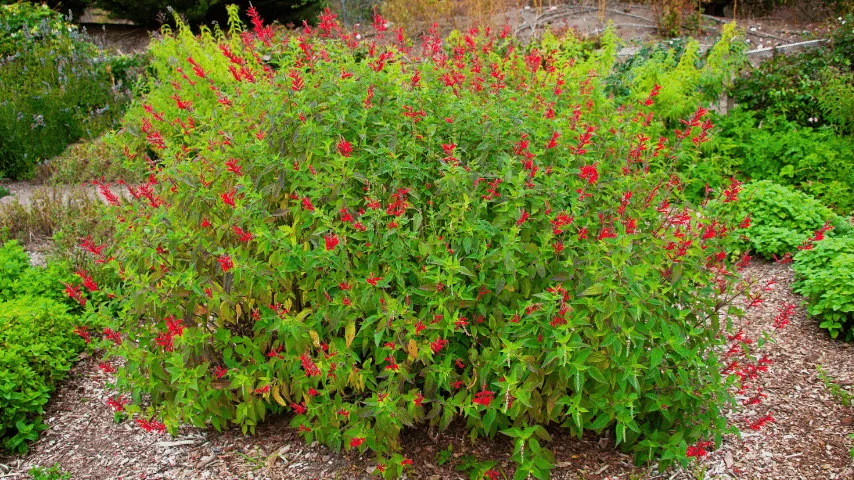
This plant has hairy, ovate, and green foliage. The flowers and leaves of this plant can be eaten as well.
You can grow it as annuals; you can grow it in pots and containers. During winter, you can place them indoors.
Following are the binomial nomenclature and basic plant care requirements:
- Scientific name: Salvia elegans
- Family: Lamiaceae
- Temperature: 20 degrees Fahrenheit or above (-6 degrees Celsius)
- Fertilizer: Use blooming fertilizer with an N-P-K number of 7-9-5.
- pH: 6.1 to 8.5
- Soil: Well-drained
- Lighting: Full sun, part shade
- Growth rate: Moderate to the high growth rate
- Humidity: Low to moderate humidity
6. Canary Island Sage
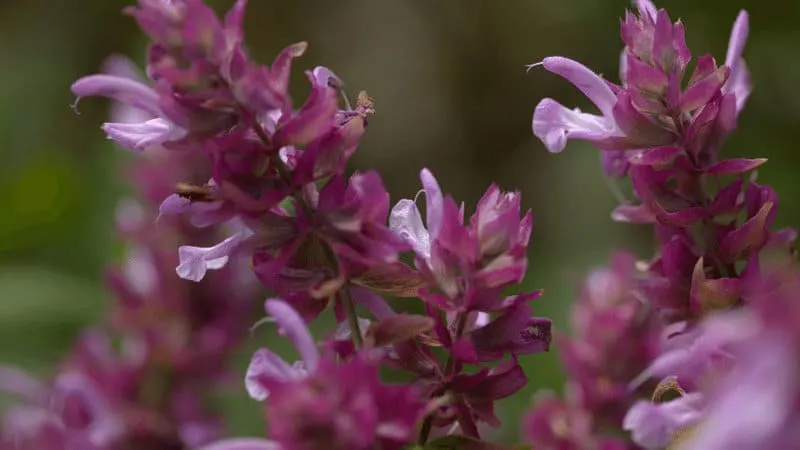
They are large growing plants. They reach up to the height of 6 to 8 feet and the width of 10 feet.
They display purple and magenta flowers in the beginning or mid-spring.
Following are the binomial nomenclature and basic plant care requirements:
- Scientific name: Salvia canariensis
- Family: Lamiaceae
- Temperature: 60 to 66 degrees Fahrenheit (16 to 19 degrees Celsius)
- Fertilizer: They do not need fertilizers
- pH: 5.8 to 6.2
- Soil: Well-drained, moist soil
- Lighting: Full sun
- Growth rate: Fast-growing
- Humidity: 68%
7. Hummingbird Sage
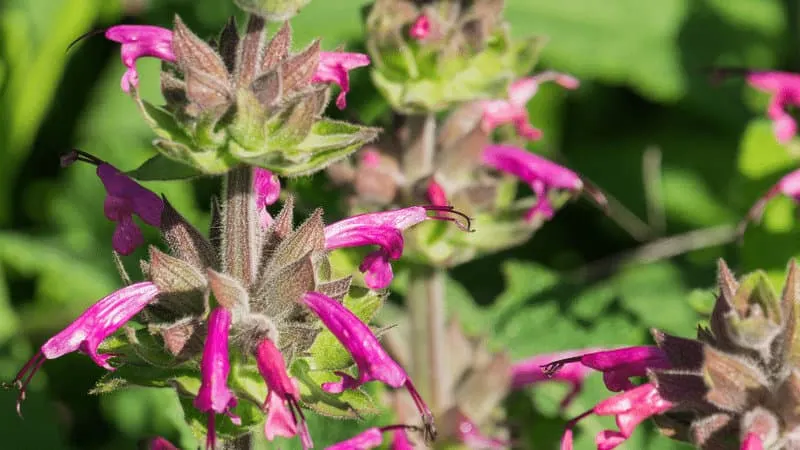
They are perennial plants that grow up to 12-18 inches tall. In the spring season, beautiful magenta-colored flowers grow.
The leaves of this plant are 4-6 inches long.
Following are the binomial nomenclature and basic plant care requirements:
- Scientific name: Salvia spathacea
- Family: Lamiaceae
- Temperature: 60 to 66 degrees Fahrenheit (16 – 19 degrees Celsius)
- Fertilizer: Apply light and balanced fertilizer in early spring
- pH: 5.0 to 7.0
- Soil: Moderately fertile, well-drained soils
- Lighting: 6 hours of sunlight daily
- Growth rate: Its growth rate differs depending on conditions. It spreads quickly in moist clay soils and slowly in sandy coastal soils.
- Humidity: High
8. Jerusalem Sage
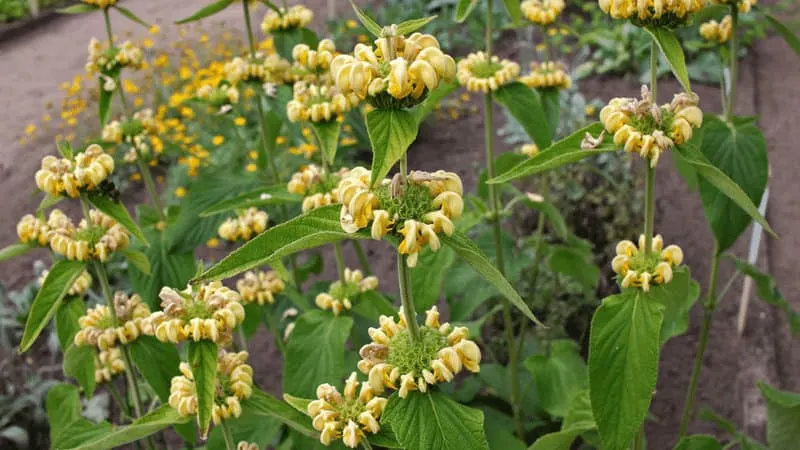
It grows in the warm season. It grows up to a height and width of three to four feet.
It has greyish-green leaves, and yellow blossoms grow at the end of spring through early summers.
Following are the binomial nomenclature and basic plant care requirements:
- Scientific name: Phlomis fruticosa
- Family: Lamiaceae
- Temperature: 50 degrees Fahrenheit (10 degrees Celsius)
- Fertilizer: Apply ammonium phosphate fertilizer in spring.
- pH: 4.5 to 8
- Soil: Well-drained, fertile soil
- Lighting: Full sun
- Growth rate: Fast-growing
- Humidity: Low to moderate
9. Grape-Scented Sage
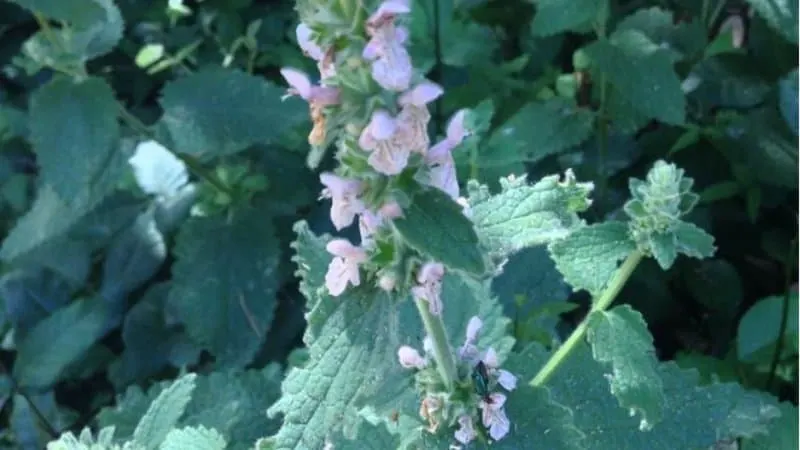
The grape-scented sage plant has a height of 6 feet and a width of 4 feet.
The leaves have protruding veins on the underside and are green in color.
The flower contains nectar which attracts bees, insects, butterflies, etc.
Following are the binomial nomenclature and basic plant care requirements:
- Scientific name: Salvia melissodora
- Family: Lamiaceae
- Temperature: 20 to 25 degrees Fahrenheit (-6 to -3 degrees Celsius)
- Fertilizer: Apply the fertilizer to the soil before spring planting.
- pH: 6.1 to 7.8
- Soil: Well-drained
- Lighting: Full sun, part shade
- Growth rate: Average growing plant
- Humidity: Low to moderate
10. Greek Sage
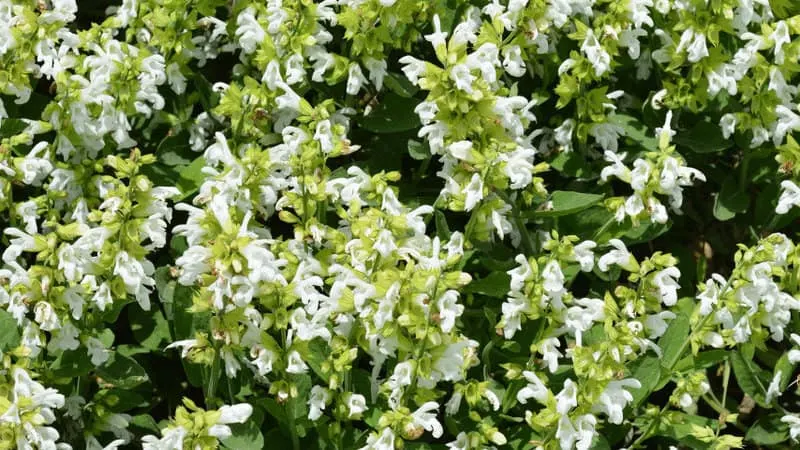
They grow up to the height and width of 2 to 3 feet. The flower stalks grow 1 foot or more above the plant.
The leaves of various sizes develop on the plant. And the flowers are pinkish-lavender and 5 inches long.
Following are the binomial nomenclature and basic plant care requirements:
- Scientific name: Salvia fruticosa
- Family: Lamiaceae
- Temperature: 60 to 66 degrees Fahrenheit (16 to 19 degrees Celsius)
- Fertilizer: Apply light and balanced fertilizer in early spring
- pH: 5.0 to 7.0
- Soil: Well-drained
- Lighting: 6 hours of direct sunlight
- Growth rate: Moderate growth rate
- Humidity: High humidity
11. Clary Sage
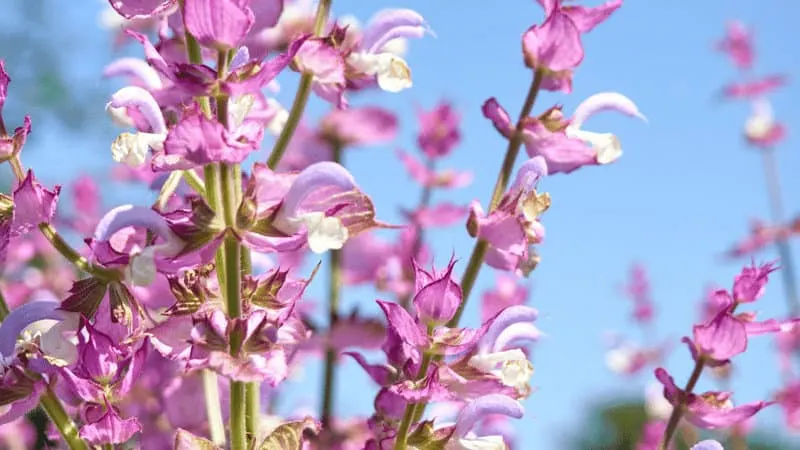
This perennial plant grows up to 3 to 4 feet in height. The stems are thick and covered with hair. Each sepal contains 2 to 6 flowers.
Following are the binomial nomenclature and basic plant care requirements:
- Scientific name: Salvia sclarea
- Family: Lamiaceae
- Temperature: 65 to 85 degrees Fahrenheit (18 to 29 degrees Celsius)
- Fertilizer: They do not need fertilizing
- pH: 4.8 to 7.5
- Soil: Well-drained soil
- Lighting: Full sun
- Growth rate: Fast-growing
- Humidity: Moderate
12. Cleveland Sage

They are also called Fragrant sage or Blue sage.
They are small in size, attractive, and highly aromatic plants.
The plant is covered with glandular hair and is grey-green in color.
The leaves of this plant are wrinkled with a leathery texture.
Following are the binomial nomenclature and basic plant care requirements:
- Scientific name: Salvia clevelandii
- Family: Lamiaceae
- Temperature: 60 to 66 degrees Fahrenheit (16 to 19 degrees Celsius)
- Fertilizer: They do not need fertilizer
- pH: 6.0 to 8.0
- Soil: Well-drained soil, fertile
- Lighting: Full sun
- Growth rate: Fast-growing
- Humidity: Moderate
13. Diviner’s Sage
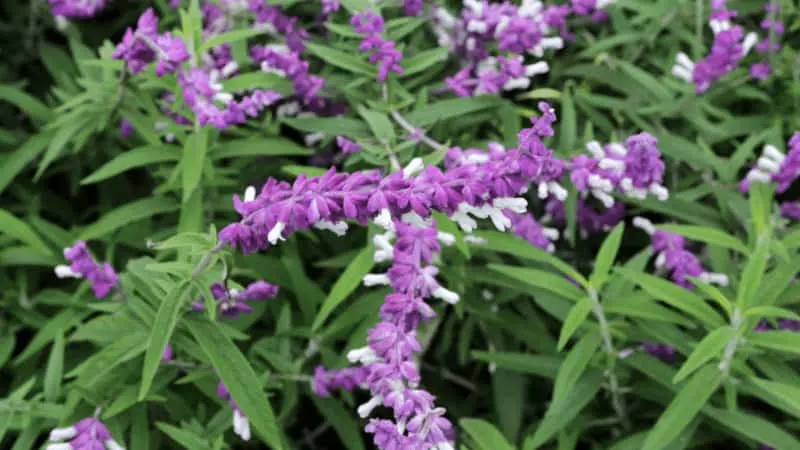
They have attractive purple-colored flowers.
The stalks of this plant readily break and do not bloom readily.
Following are the binomial nomenclature and basic plant care requirements:
- Scientific name: Salvia divinorum
- Family: Lamiaceae
- Temperature: 60 to 66 degrees Fahrenheit (16 to 19 degrees Celsius)
- Fertilizer: Apply light fertilizer in early spring
- pH: 5.8 to 6.2
- Soil: Well-drained, rich in humus
- Lighting: Part shade
- Growth rate: Moderate growth
- Humidity: High Humidity
14. Anise-Scented Sage
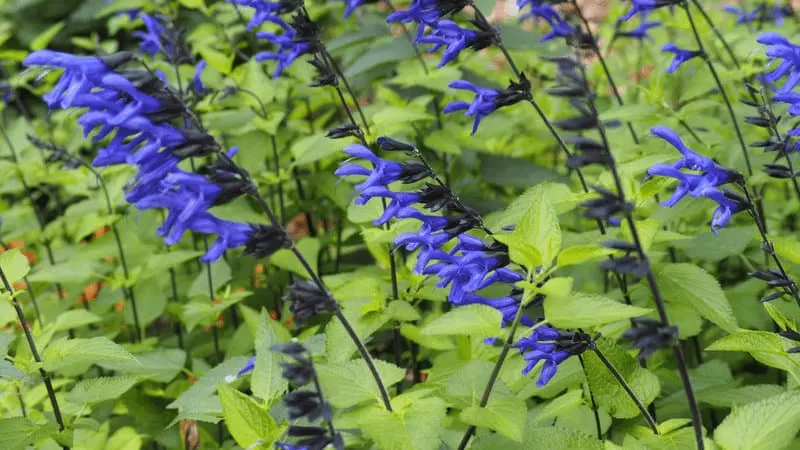
It is also called Brazilian sage. It is a perennial sub-shrub that grows up to four to five feet high.
The foliage is mint green in color, and they are ovate.
Following are the binomial nomenclature and basic plant care requirements:
- Scientific name: Salvia guaranitica
- Family: Lamiaceae
- Temperature: 60 to 66 degrees Fahrenheit (16 to 19 degrees Celsius)
- Fertilizer: They need little or no fertilizer. Apply a balanced liquid fertilizer monthly.
- pH: 5.5 to 6.5
- Soil: Moist, well-drained soil
- Lighting: Full sun, part shade
- Growth rate: Fast-growing
- Humidity: Moderate 50%
15. Autumn Sage
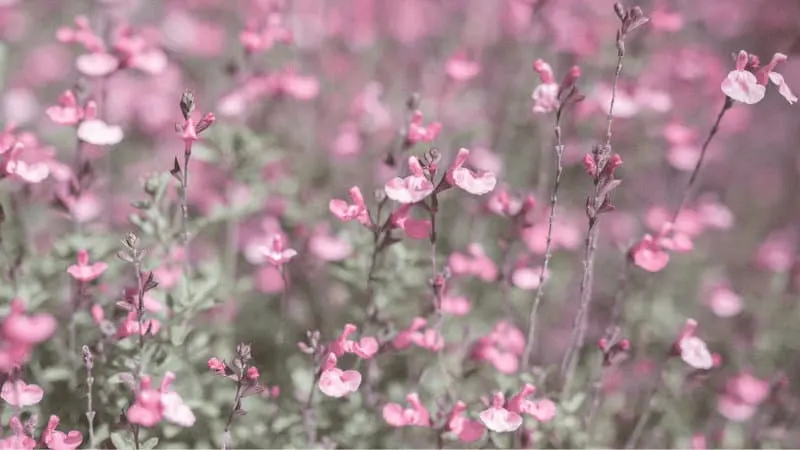
This evergreen shrub grows up to the height and width of 3 feet.
The leaves are small, dark green in color, and have a little sticky coating.
There are various colors of its flower, including pink, orange, white and purple.
Following are the binomial nomenclature and basic plant care requirements:
- Scientific name: Salvia greggii
- Family: Lamiaceae
- Temperature: 15 degrees Fahrenheit (-9 degrees Celsius)
- Fertilizer: Apply slow-release fertilizer at the base in the spring
- pH: 6.1 to 7.8
- Soil: moderately fertile, well-drained soil
- Lighting: Full sun
- Growth rate: Fast-growing
- Humidity: Low humidity
16. Common Garden Sage
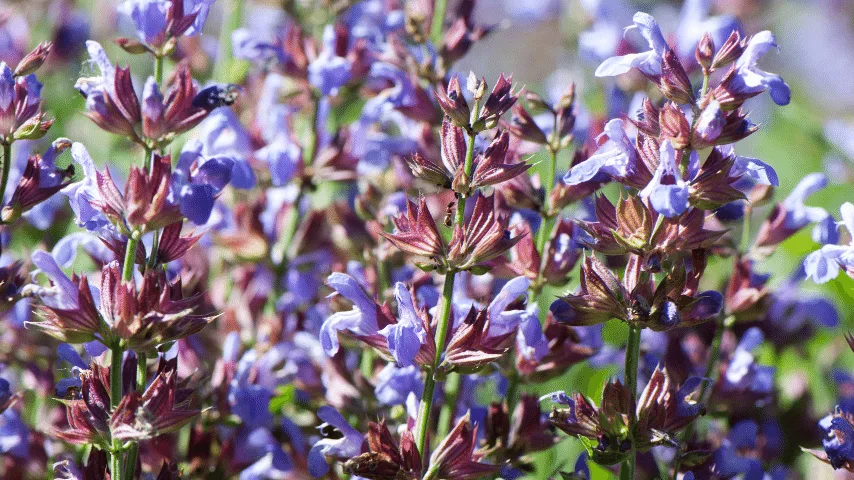
They are also called true sage, golden sage, or culinary sage. They are bushy and reach a height of 3 feet.
The leaves of this plant are slightly hairy and silvery-green in color. The aromatic leaves of this plant can be used for cooking.
Following are the binomial nomenclature and basic plant care requirements:
- Scientific name: Salvia officinalis
- Family: Lamiaceae
- Temperature: -20 to 10 degrees Fahrenheit (-29 to -23 degrees Celsius)
- Fertilizer: They do not need fertilizers
- pH: 5.6 to 7.8
- Soil: Well-drained soil
- Lighting: Full sun
- Growth rate: Moderate growth rate
- Humidity: Moderate
17. Fragrant Pitcher Sage
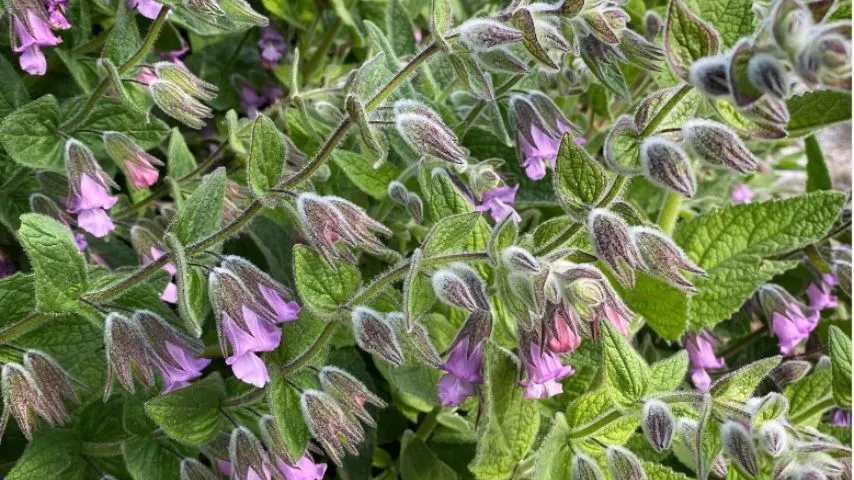
They are flowering herbaceous shrubs. They grow up to the height of 3 to 5 feet tall and 3 to 6 feet wide.
They produce dark or light purple flowers. The crushed foliage produces a pleasant scent.
Following are the binomial nomenclature and basic plant care requirements:
- Scientific name: Lepechinia fragrans
- Family: Lamiaceae
- Temperature: 60 to 66 degrees Fahrenheit (16 to 19 degrees Celsius)
- Fertilizer: They do not need fertilizers
- pH: 6.0 to 7.0
- Soil: Well-drained soil
- Lighting: Full sun, part shade
- Growth rate: Fast to moderate growing
- Humidity: High
18. Woodland Sage
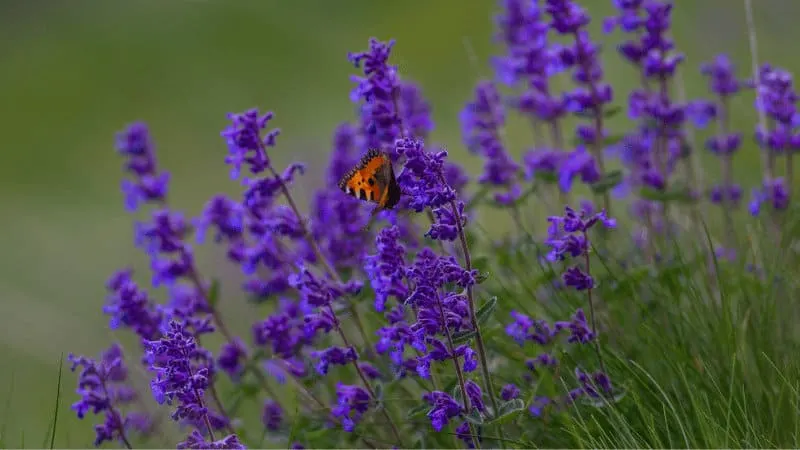
They are also known as wild sage. Their violet-blue flowers grow from June to September. The flower attracts butterflies and bees.
Following are the binomial nomenclature and basic plant care requirements:
- Scientific name: Salvia nemorosa
- Family: Lamiaceae
- Temperature: 68 to 72 degrees Fahrenheit (20 to 22 degrees Celsius)
- Fertilizer: Apply liquid fertilizer each time you water the plants
- pH: 6.0 to 6.5
- Soil: Moist, Well-drained soil
- Lighting: Full sun, part shade
- Growth rate: Moderate to fast-growing
- Humidity: Moderate humidity
20. Scarlet Sage
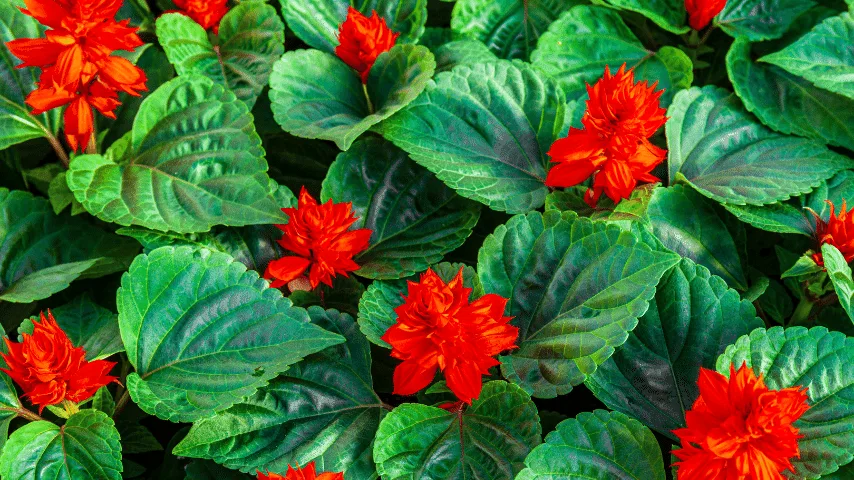
They are also called red Salvia. They are tropical perennials.
This sage plant grows from July to frost. They reach up to the height of 18 to 30 inches until maturity.
Following are the binomial nomenclature and basic plant care requirements:
- Scientific name: Salvia splendens
- Family: Lamiaceae
- Temperature: 65 to 75 degrees Fahrenheit (18 to 23 degrees Celsius)
- Fertilizer: Apply time-release fertilizer when planting scarlet sage herb in spring
- pH: 5.5 to 6.0
- Soil: Sandy loam, fertile, well-drained soil
- Lighting: Full sun
- Growth rate: Fast-growing
- Humidity: Moderate 50%
Sage Companion Plants
Great sage companion plants are Oregano, Thyme, and Rosemary. Ideal companion plants don’t like their soil to be too wet. Sage is drought-tolerant and does not like damp soil.
Read more about Sage companion plants.
Different Types of Sage Plants
Some popular types of sage plants are Salvia officinalis (common sage), Salvia nemorosa (woodland sage), Salvia farinacea (mealycup sage), Salvia lyrata (lyre-leaved sage), Salvia sclarea (clary sage), Salvia lavandulaefolia (Spanish sage), Salvia leucantha (Mexican bush sage) and Salvia clevelandii (Cleveland sage). There are more than 900 different types of sage plants.

Daniel has been a plant enthusiast for over 20 years. He owns hundreds of houseplants and prepares for the chili growing seasons yearly with great anticipation. His favorite plants are plant species in the Araceae family, such as Monstera, Philodendron, and Anthurium. He also loves gardening and is growing hot peppers, tomatoes, and many more vegetables.

